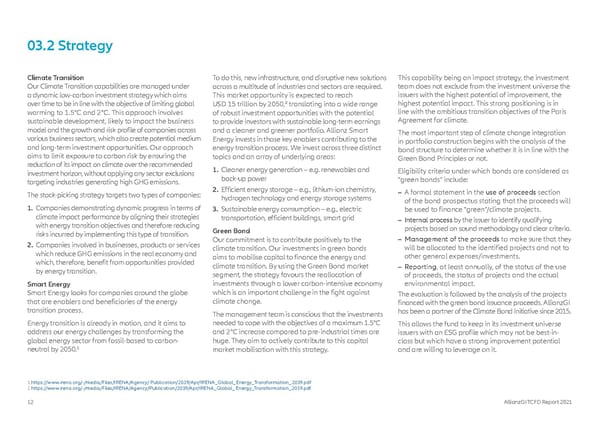03.2 Strategy Climate Transition To do this, new infrastructure, and disruptive new solutions This capability being an impact strategy, the investment Our Climate Transition capabilities are managed under across a multitude of industries and sectors are required. team does not exclude from the investment universe the a dynamic low-carbon investment strategy which aims This market opportunity is expected to reach issuers with the highest potential of improvement, the over time to be in line with the objective of limiting global USD 15 trillion by 2050,2 translating into a wide range highest potential impact. This strong positioning is in warming to 1.5°C and 2°C. This approach involves of robust investment opportunities with the potential line with the ambitious transition objectives of the Paris sustainable development, likely to impact the business to provide investors with sustainable long-term earnings Agreement for climate. model and the growth and risk profile of companies across and a cleaner and greener portfolio. Allianz Smart The most important step of climate change integration various business sectors, which also create potential medium Energy invests in those key enablers contributing to the in portfolio construction begins with the analysis of the and long-term investment opportunities. Our approach energy transition process. We invest across three distinct bond structure to determine whether it is in line with the aims to limit exposure to carbon risk by ensuring the topics and an array of underlying areas: Green Bond Principles or not. reduction of its impact on climate over the recommended 1. Cleaner energy generation – e.g. renewables and investment horizon, without applying any sector exclusions Eligibility criteria under which bonds are considered as targeting industries generating high GHG emissions. back-up power “green bonds” include: The stock-picking strategy targets two types of companies: 2. Efficient energy storage – e.g., lithium-ion chemistry, – A formal statement in the use of proceeds section hydrogen technology and energy storage systems of the bond prospectus stating that the proceeds will 1. Companies demonstrating dynamic progress in terms of 3. Sustainable energy consumption – e.g., electric be used to finance “green”/climate projects. climate impact performance by aligning their strategies transportation, efficient buildings, smart grid – Internal process by the issuer to identify qualifying with energy transition objectives and therefore reducing Green Bond projects based on sound methodology and clear criteria. risks incurred by implementing this type of transition. Our commitment is to contribute positively to the – Management of the proceeds to make sure that they 2. Companies involved in businesses, products or services climate transition. Our investments in green bonds will be allocated to the identified projects and not to which reduce GHG emissions in the real economy and aims to mobilise capital to finance the energy and other general expenses/investments. which, therefore, benefit from opportunities provided climate transition. By using the Green Bond market – Reporting, at least annually, of the status of the use by energy transition. segment, the strategy favours the reallocation of of proceeds, the status of projects and the actual Smart Energy investments through a lower carbon-intensive economy environmental impact. Smart Energy looks for companies around the globe which is an important challenge in the fight against The evaluation is followed by the analysis of the projects that are enablers and beneficiaries of the energy climate change. financed with the green bond issuance proceeds. AllianzGI transition process. The management team is conscious that the investments has been a partner of the Climate Bond Initiative since 2015. Energy transition is already in motion, and it aims to needed to cope with the objectives of a maximum 1.5°C This allows the fund to keep in its investment universe address our energy challenges by transforming the and 2°C increase compared to pre-industrial times are issuers with an ESG profile which may not be best-in- global energy sector from fossil-based to carbon- huge. They aim to actively contribute to this capital class but which have a strong improvement potential 1 neutral by 2050. market mobilisation with this strategy. and are willing to leverage on it. 1.https://www.irena.org/-/media/Files/IRENA/Agency/ Publication/2019/Apr/IRENA_Global_Energy_Transformation_2019.pdf 2.https://www.irena.org/-/media/Files/IRENA/Agency/Publication/2019/Apr/IRENA_Global_ Energy_Transformation_2019.pdf 12 AllianzGI TCFD Report 2021
 TCFD Report Page 11 Page 13
TCFD Report Page 11 Page 13